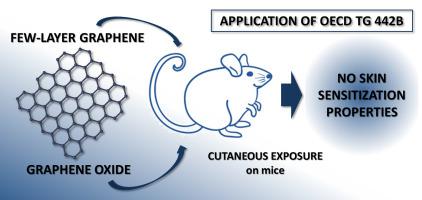NanoImpact ( IF 4.9 ) Pub Date : 2022-12-21 , DOI: 10.1016/j.impact.2022.100448 Silvio Sosa 1 , Aurelia Tubaro 1 , Michela Carlin 1 , Cristina Ponti 1 , Ester Vázquez 2 , Maurizio Prato 3 , Marco Pelin 1

|
Skin contact is one of the most common exposure routes to graphene-based materials (GBMs) during their small-scale and industrial production or their use in technological applications. Nevertheless, toxic effects in humans by cutaneous exposure to GBMs remain largely unexplored, despite skin contact to other related materials has been associated with adverse effects. Hence, this in vivo study was carried out to evaluate the cutaneous effects of two GBMs, focusing on skin sensitization as a possible adverse outcome.
Skin sensitization by few-layer graphene (FLG) and graphene oxide (GO) was evaluated following the Organization for Economic Cooperation and Development (OECD) guideline 442B (Local Lymph Node Assay; LLNA) measuring the proliferation of auricular lymph node cells during the induction phase of skin sensitization. Groups of four female CBA/JN mice (8–12 weeks) were daily exposed to FLG or GO through the dorsal skin of each ear (0.4–40 mg/mL, equal to 0.01–1.00 mg/ear) for 3 consecutive days, and proliferation of auricular lymph node cells was evaluated 3 days after the last treatment. During this period, no clinical signs of toxicity and no alterations in body weight and food or water consumptions were observed. In addition, no ear erythema or edema were recorded as signs of irritation or inflammation. Bromo-deoxyuridine (BrdU) incorporation in proliferating lymphocytes from ear lymph nodes (stimulation indexes <1.6) and the histological analysis of ear tissues excluded sensitizing or irritant properties of these materials, while myeloperoxidase activity in ear biopsies confirmed no inflammatory cells infiltrate. On the whole, this study indicates the absence of sensitization and irritant potential of FLG and GO.
中文翻译:

通过局部淋巴结测定 (OECD TG 442B) 评估少层石墨烯和氧化石墨烯的皮肤致敏特性
皮肤接触是石墨烯基材料 (GBM) 在小规模和工业生产或技术应用中最常见的接触途径之一。然而,皮肤接触 GBM 对人体的毒性作用在很大程度上仍未得到探索,尽管皮肤接触其他相关材料已与不良反应相关。因此,进行这项体内研究以评估两种 GBM 的皮肤影响,重点关注皮肤致敏作为可能的不良结果。
根据经济合作与发展组织 (OECD) 指南 442B(局部淋巴结测定;LLNA)测量诱导过程中耳淋巴结细胞的增殖,评估了少层石墨烯 (FLG) 和氧化石墨烯 (GO) 对皮肤的致敏作用皮肤致敏阶段。每组四只雌性 CBA/JN 小鼠(8-12 周)每天通过每只耳朵的背部皮肤暴露于 FLG 或 GO(0.4-40 mg/mL,等于 0.01-1.00 mg/耳)连续 3 天,最后一次治疗后 3 天评估耳廓淋巴结细胞的增殖情况。在此期间,没有观察到毒性的临床体征,也没有观察到体重和食物或水消耗量的变化。此外,没有耳朵红斑或水肿被记录为刺激或炎症的迹象。溴脱氧尿苷 (BrdU) 掺入来自耳淋巴结的增殖淋巴细胞(刺激指数 <1.6)和耳组织的组织学分析排除了这些材料的致敏或刺激特性,而耳活检中的髓过氧化物酶活性证实没有炎症细胞浸润。总的来说,这项研究表明 FLG 和 GO 不存在致敏和刺激潜力。



























 京公网安备 11010802027423号
京公网安备 11010802027423号